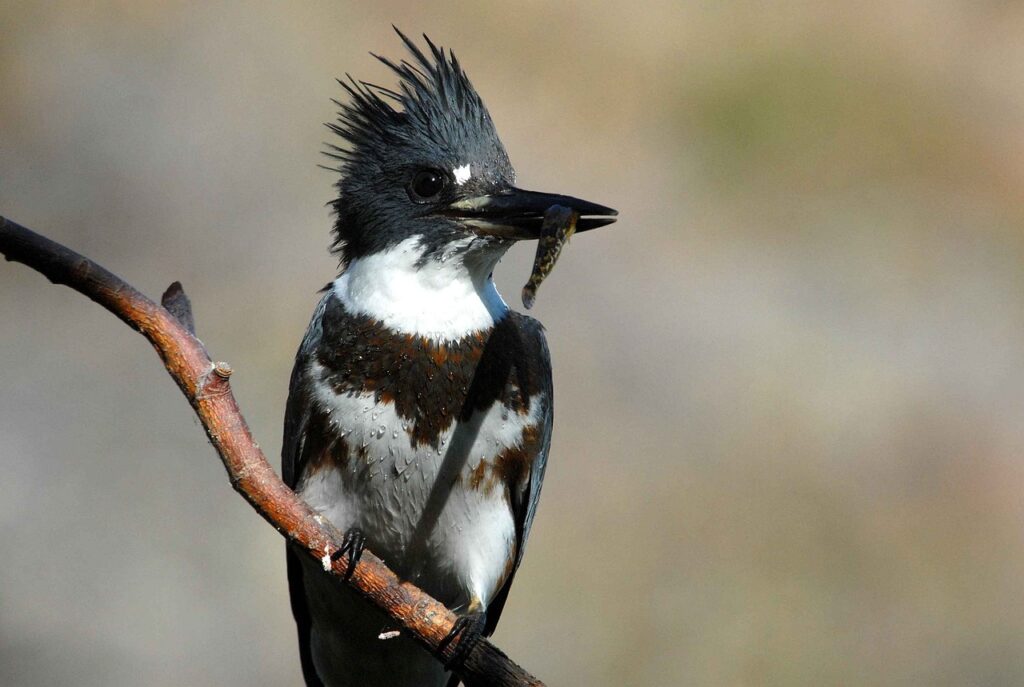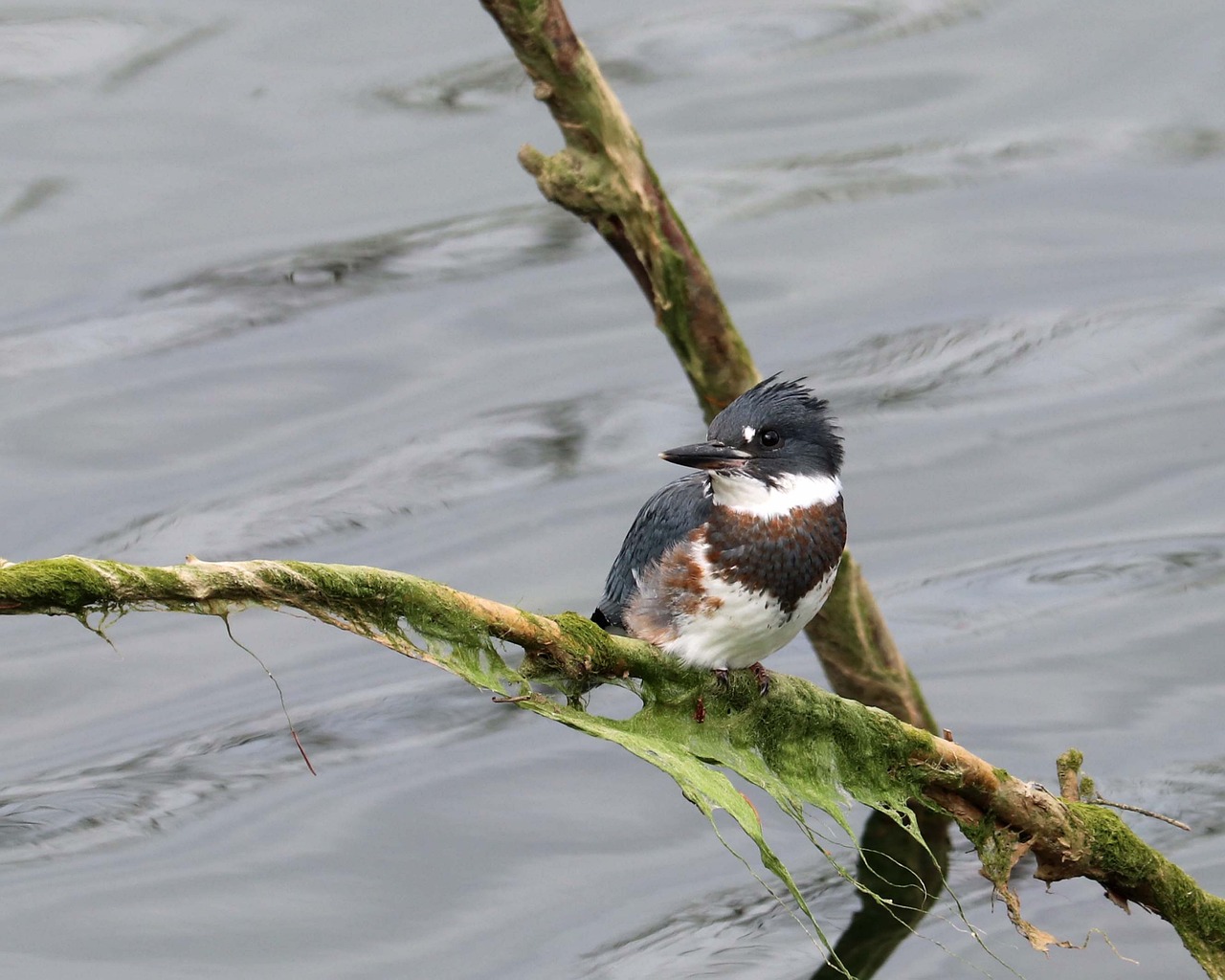The Belted Kingfisher (Megaceryle alcyon) is a stocky, medium-sized bird frequently seen perched atop branches overhanging bodies of water. This species inhabits a variety of aquatic habitats across much of North America, ranging from small ponds to large rivers and coastal estuaries.
It has distinctive coloration that makes it an easily recognizable inhabitant of wetlands: the male’s plumage is primarily blue-gray while the female’s plumage is more brownish in hue.
Belted Kingfishers are active hunters during both day and night, using their keen vision to spot prey as they fly along shorelines or hover above the surface of the water. They typically feed on fish and crustaceans by either plunging into the water for submerged prey or catching them at the surface with their bill. Breeding pairs will also sometimes use insects or other invertebrates as food items for their young.
This article aims to provide an overview of Belted Kingfishers’ physical characteristics, habitat preferences, behavioral traits, diet, breeding habits and population trends throughout its range in order to gain a better understanding of this iconic wetland species.

Habitat And Range
The belted kingfisher is a fish-eating bird that can be found in many natural habitats. Its range includes most of North America and some parts of Central America, including the Caribbean Islands. This species can generally be seen near both coastal areas and inland waterways.
Belted kingfishers are usually seen perched on trees or posts overhanging water, where they make their nests by burrowing into the sides of steep banks. They hunt for small fish, amphibians, aquatic insects, crustaceans, and mollusks while hovering above the water before diving to capture prey with its sharp bill.
These birds often travel along rivers and streams searching for food such as crayfish and minnows; however, they also venture away from bodies of freshwater in search of food sources when needed.
Characteristics
The belted kingfisher is a medium-sized bird with a distinctive plumage color and crest shape. The upper parts of the body are slate blue, while the underparts are white. A chestnut band runs across its breast and divides the two colors along its belly. Its tail feathers are long and have faint barring on their tips. This species also has a prominent crest that stands upright when alert or excited.
The bill size of this species ranges from 1 to 2 inches in length; it is thick at the base and pointed at the tip. Both sexes look similar but males tend to be slightly larger than females.
Belted kingfishers make loud vocalizations that sound like rattling calls or ‘kih’ sounds as they search for food around streams and rivers. They may also emit shrill cries when defending their territories against intruders, although these vocalizations vary between individuals.
Diet And Foraging Habits
The belted kingfisher has a diet that consists mainly of fish species, such as minnows and catfish. They also hunt for insects like crayfish, beetles, and dragonflies in shallow waters. Foraging habits vary depending on the availability of prey species; they may fly around rivers or streams searching for food along the shoreline or hover over open water before diving to catch their meal.
Belted kingfishers use different techniques when hunting, including hovering above water while scanning for prey then quickly plunging into the water to snatch up fish with their bill. Alternatively, they may perch on branches close to the surface of water and watch for movement below them before swooping down to capture their target.
In some cases, this species will even chase after larger prey items by flying alongside them until they can be grasped with its talons or bill. The fishing skills displayed by these birds make them an efficient predator capable of catching a wide variety of aquatic creatures for their diet.
Breeding Behavior
The breeding behavior of the belted kingfisher is quite elaborate and typically occurs during spring or early summer. During this time, they will begin to build their nests that are typically cup-shaped structures made from sticks and other debris found near rivers or streams.
After nest building has been completed, courtship rituals will ensue with pairs performing aerial displays in an effort to attract a mate.
Once a pair has bonded, clutches of between four to eight eggs will be laid over the course of several days. Both parents have an active role in incubation which takes place for around 18 days before chicks hatch.
Following hatching both adults take part in feeding duties until the youngsters can fledge at around 27 days old. The young birds remain dependent on their parents for some time after fledging as they learn how to hunt effectively and gain strength by flying long distances.
Migration Patterns
Migration patterns of the belted kingfisher are complex and involve seasonal movements to wintering areas as well as long-distance migrations. Belted kingfishers breeding in northern parts of their range will migrate southward during fall and early winter months, while those living further south may only move short distances or not at all depending on climate conditions.
During migration, these birds typically fly in a straight line along predictable routes and rest for periods of time at various points along the way.
Wintering areas can vary from year to year with some individuals staying put throughout the colder months while others travel even greater distances than during spring and summer migrations.
Despite this variation, research has shown that most adult birds return to the same region each year to breed although it is unknown if they use the same nesting sites consistently. By understanding more about these species’ migration behavior, conservation efforts can be better tailored towards protecting important habitats used by migrating belted kingfishers.

Conservation Status
The conservation status of the belted kingfisher is of concern due to a variety of human-driven threats. Degradation and destruction of their habitats, including wetlands and riparian areas, is one of the most significant contributing factors to population declines.
In addition, pollution from agricultural runoff has been linked to decreased reproductive success in these birds as well as other species that rely on healthy aquatic ecosystems for survival. Furthermore, collisions with manmade structures such as windows or power lines can be deadly for migrating individuals.
Fortunately, efforts are being made to protect this species through various research initiatives and conservation programs aimed at preserving key habitat sites and mitigating human impacts on their environment.
For example, designated Critical Habitat Areas have been established across much of the United States specifically for migratory bird populations including belted kingfishers which provide them with some measure of safety during winter months when food sources may be scarce.
Ongoing monitoring projects are providing essential data about population trends so that management strategies can be better informed and adapted accordingly over time.
Interesting Facts
The belted kingfisher is an easily recognizable species due to its distinct features and habits. One of the most iconic aspects of this bird is its loud, raspy call which can be heard echoing across many wetlands during spring and summer months.
In terms of physical characteristics, they possess a blue-gray plumage with white spots on their wings and a chestnut band around their neck that gives them their namesake. Additionally, these birds are well adapted for fishing with long bills perfect for catching fish as well as other aquatic prey like crayfish or frogs.
Another interesting behavior associated with the belted kingfisher is its courtship rituals. During mating season, pairs will display intricate aerial acrobatics in order to attract potential mates before settling into nesting sites near water sources.
Uniquely, males have a longer bill shape than females which allows them to better reach food hidden deep within crevices while also allowing them to more effectively defend themselves from predators.
These fascinating behaviors and adaptations make the belted kingfisher one of North America’s most beloved avian species. With ongoing protection efforts and increased public awareness about threats facing migratory birds, hopefully populations of this charismatic creature will continue to thrive in years to come.

